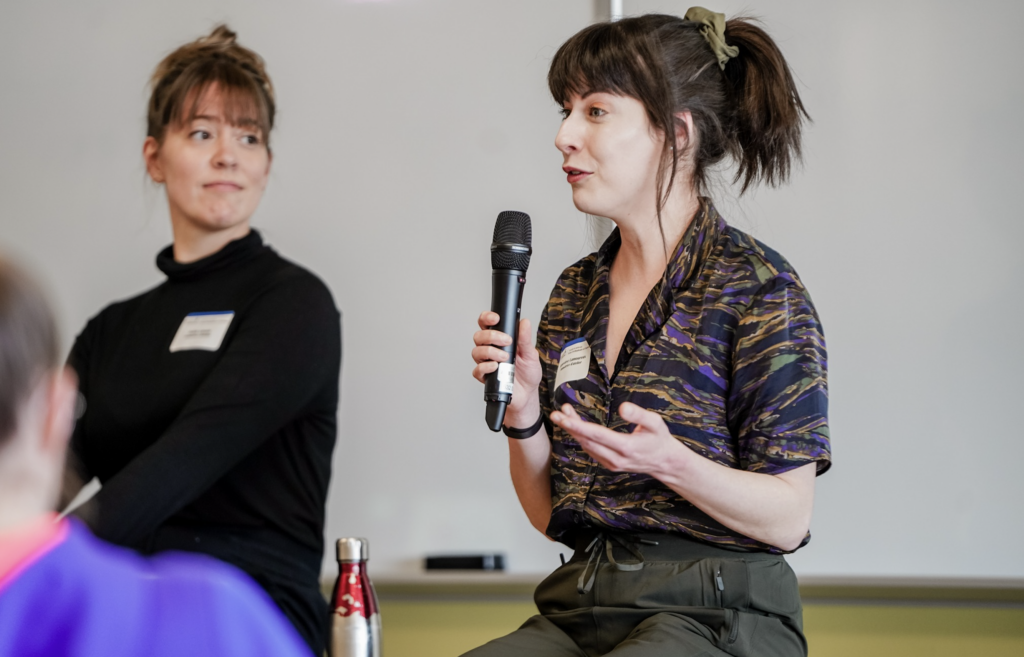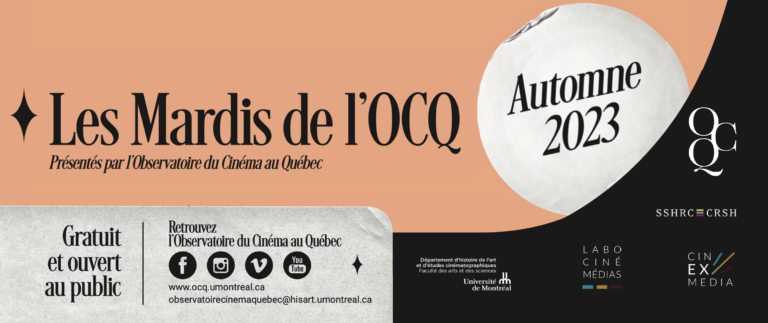The doctoral student Geneviève Lamoureux is working on a research-action project with the goal of identifying good practices for depicting stuttering.

Lou Andrysiak
Because cinEXmedia’s mandate is intersectoral, the partnership supports projects in all sorts of fields which can nevertheless have a connection to audiovisual culture. This is the case with the research of speech therapist Geneviève Lamoureux, a doctoral student in the l’École d’orthophonie et d’audiologie at the Université de Montréal.
She is carrying out a research-action project which seeks to create resources for raising the awareness of people in the television, radio, performing arts and journalism communities around questions of “communicational diversity”. This concept refers to various forms of speaking, including stuttering, aphasia and other language problems.
Geneviève Lamoureux, who spoke with us about her research, has asked that we preserve the marks of her stuttering in our article in order to better represent her.
“Communic-cational diversity is a form of neurodiversity – which includes for example autism, attention deficit disorder and dyslexia – and suggests that our neu-eurological differences can be seen as something other than lim-mitations”, she explains. “These differences can prove to be en-en-enriching for s-society”.
Research-Action
Lamoureux’s research is being supervised by Ingrid Verduyckt, an associate professor in the École d’orthophonie et d’audiologie, and by Luci-Ménard, a full professor in the Département de linguistique at the Université du Québec à Montréal (UQAM). It is, in addition, a research-action project, meaning an approach to scientific research which involves the participants concerned as experts in their own reality and makes it possible to propose concrete transformative actions concerning the object of study.
Geneviève Lamoureux thus hopes to “establish principles for accurate depictions by creating tools and resources (written and audiovisual) to inform and raise the awareness of media professionals, such as journalists and scr-scriptwriters, so that they are able to a-adapt our realities to their own”. Several studies are being carried out, she remarks, with discussion groups made up of people who stutter, their friends and family, speech therapists, and interivews with media professionals.
This year, she is beginning new research with the support of cinEXmedia: “We want, first of all, to establish principles, like good practices with respect to communicational diversity, and to examine a body of films to study the extent to which these principles are observed. This will enable us to h-have access to concrete examples and counter-examples”. She emphasises that in films stuttering is often reduced to stereotypes.
Appreciate the Beauty
“The way communication dis-disabilities are depicted in the media today is to make them in-in-invisible. No one speaks of them. To make them in-in-invisible is a form of mar-marginalization. When something isn’t shown, it’s like you aren’t worthy of e-existing in these spaces”, Lamoureux laments.
This is why she is interrogating the notions communicational diversity and diverse abilities in her work. The importance of the latter is also recognized by the Canada Research Chair in Cultural Citizenship of Deaf People and Cultural Equity Practices, based at UQAM.
Diverse ability “applies in particular to the body, to people in wh-wheelchairs who are deaf”, Lamoureux continues. “The Chair carries out research on this r-richness, but mostly with respect to the performing arts. For example, it may be a question of a silent s-s-stage play, where you don't express yourself with spoken language, but with sign language”.
The concepts communicational diversity and diverse ability should also be employed in the media, according to Lamoureux: “They make possible a more valuable connection w-with vulnerability and greater patience with the other”. She would also like the media to avoid correcting stuttering so that the public can appreciate “the beauty of this way of spe-speaking”.
Beyond the Walls of the University
Since October 2020, Geneviève Lamoureux has co-hosted and co-produced the podcast Je je je suis un podcast, with the speech therapist Judith Labonté. There they take up stuttering and use their platform like a kind of liberation of speech. More than 49 episodes are already available on their YouTube page. The podcast is produced in collaboration with the Association bégaiement communication, which works with adults who stutter and with whom Lamoureux first began volunteering in 2015.
For her doctoral studies, Lamoureux has also received a Dialogue grant from the Fonds de recherche du Québec in order to organize events for disseminating her knowledge and research among a variety of audiences.
In this way Geneviève Lamoureux is fighting against the forms of discrimination which people with a speech disorder undergo on a daily basis. “Pe-pe-people va-valorize fluid communication skills in the media, without considering that this is something that not ev-everyone has”, she laments, hoping to be able to contribute, if only modestly, to bringing about change.

